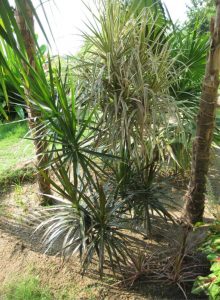By Tommy Clarkson from the April 2013 Edition

Dracaena Marginata
Family: Agavaceae, Ruscaceae or Dracaenaceae
(Opinions, obviously, vary!)
(Also known as Dragon Tree, Red Edged Dracaena, Money Tree or Rainbow Tree)
Now that’s a name to conjure all sorts of intriguing images, is it not? But at least we needn’t puzzle over from what region it originated! But about those dragons .. . .
Well, those mythical beasties notwithstanding, this character along with various new hybrids is a popular interior home or office plant in addition to being great for your tropical garden. They are enjoyed, not for their flowers but for their foliage, inside or outdoors, and are ideal as an architectural plant.
But is it a shrub or a tree? Like its family identification, it depends upon who one asks as it’s identified as either. However, with a snakelike or cane appearing trunk, its capable of growing quite tall nearly eight meters (25’).
These slender trunks can be grown straight to produce a tall plant or be trained to twist, bend and curve so as to have character. That being noted, as a result of their somewhat malleable presentation forms, they are generally employed in tropical gardens in lower versions providing a splash of uniqueness and enjoyable color. One might call them the Elton John of the garden set!
The large genus, of which this is a member, includes plants that grow in a wide array of sizes and shapes sporting a diversity of leaf colorations. Those of the Madagascar Dragon Tree, however, are long, flat, arching striped with red or purple and typically 30- 90 cm long (1-3’) and 2-7 cm (1-2 ¾”) broad, tapering to a point. Beyond these, there are some fun variegated cultivars with pale yellow stripes.
Generally, several of these plants are placed at varying heights in close proximity in the ground or pot to present a total picture of a fuller specimen. In fact, at the entry to the Grand Terrace here in Ola Brisa Gardens, I have four different varieties grouped together of varying sizes and they look marvelous displaying this plant’s primary pride and purpose in life . . . its luxurious, flowing fronds. But, solitarily planted, they sorta’ look like an anorexic palm, so keep ‘em massed!

While the fully green varieties of this genus flourish in shady locales, these characters prefer partial to full sun and, but in home or office they often tolerate low sunlight. It is very accepting of dry soil and irregular watering. But – a note of warning they are susceptible to root decay in permanently wet soil. (Now what does this tell us (pause for response) Correct answer!
Like so many plants, they require well draining soil. And, speaking of giving them drinks when doing so, allow them to dry slightly

between watering. After the soil surface is dry to the touch, then water them thoroughly.
Recently, Jose had to treat one of my plants for white Scale something I heretofore not experienced with these plants. So keep an eye out for those little sucking buggers.
An interesting aspect of the Dragon Tree is that if the plant’s stems become too long and bare, simply cut them off at the desired height and new leaves will soon appear. In fact, they are easy to propagate by air layering, tip or

stem cuttings, or by the removal and rooting of basal shoots any of which should be done in the spring or late summer.
Lastly, in the category of ancillary bits of minutia, the Dracaena Marginata is said to be very susceptible to fluoride toxicity probably stemming from an overdose of insecticide. The Madagascar Dragon Tree is purported to be an effective air-cleaner but, I understand will not dust the furniture or wash the windows. And, lastly, one of my more scholarly botanical tomes states that it is among the best of plants for removing xylem and trichloroethylene.
(Knowing that to you like me, this is a major concern in our lives I appreciate how we all hate it when they build up in tiny invisible, gaseous balls in the living room corners, don’t you?)
That all having been noted, these guys are nice to have a clump or two around your home or garden!
Download the full edition or view it online
—
Tommy Clarkson is a bit of a renaissance man. He’s lived and worked in locales as disparate as the 1.2 square mile island of Kwajalein to war-torn Iraq, from aboard he and Patty’s boat berthed out of Sea Bright, NJ to Thailand, Germany, Hawaii and Viet Nam; He’s taught classes and courses on creative writing and mass communications from the elementary grades to graduate level; He’s spoken to a wide array of meetings, conferences and assemblages on topics as varied as Buddhism, strategic marketing and tropical plants; In the latter category he and Patty’s recently book, “The Civilized Jungle” – written for the lay gardener – has been heralded as “the best tropical plant book in the last ten years”; And, according to Trip Advisor, their spectacular tropical creation – Ola Brisa Gardens – is the “Number One Tour destination in Manzanillo”.





You must be logged in to post a comment.